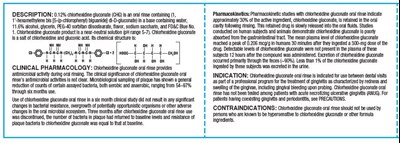Product Images Acclean Chlorhexidine Gluconate 0.12% Oral Rinse
View Photos of Packaging, Labels & Appearance
Product Label Images
The following 6 images provide visual information about the product associated with Acclean Chlorhexidine Gluconate 0.12% Oral Rinse NDC 0404-0178 by Henry Schein, Inc., such as packaging, labeling, and the appearance of the drug itself. This resource could be helpful for medical professionals, pharmacists, and patients seeking to verify medication information and ensure they have the correct product.
1 - LBL1

This is a description of a mouthwash product named ACCLEAN® ps, which contains 0.12% chlorhexidine gluconate. The product is in a 40Z (118 ML) bottle and has directions for use on the label. Users are advised to swish 1 tablespoon (15ml) in the mouth and spit it out after use, preferably after breakfast and before bedtime. The product should not be ingested and kept away from children. There is a product code number, NDC0404-0178-03, provided on the label.*
2 - LBL2a

This text is a medication guide for chlorhexidine gluconate oral rinse. It includes information on adverse reactions and common side effects, dosage and administration instructions, how it is supplied, and its potential risks and hazards if ingested. It is intended specifically for dental use and it's important not to ingest it or use other mouthwashes immediately after use. It is supplied in 4-ounce and 1-pint amber plastic bottles with child-resistant closures.*
3 - LBL3a

This text is a guide on what to expect when using Chlorhexidine Gluconate oral rinse. The rinse is prescribed by a dentist to control gum bleeding, reduce redness and swelling, and control gum disease. The rinse should be used regularly as directed by a dentist in addition to daily brushing routine. If an allergic reaction is experienced, medical advice should be sought immediately. The ingredients may cause tooth discoloration or increase in tartar formation, this can be removed by a dentist or hygienist. The rinse may taste bitter to some users and could interfere with how food and beverages taste. The rinse should not be used by individuals who have a sensitivity to it or its components. If any concerns arise, reach out to your dentist or pharmacist. The rinse is stored at 20°C to 25°C (66°F to 77°F).*
4 - LBL4a

Chlorhexidine gluconate is an oral rinse with antimicrobial properties designed for use by patients with gingivitis characterized by redness, swelling, and bleeding. The rinse contains 0.12% chlorhexidine gluconate, which is slowly released into oral fluids after use. Studies show that about 30% of the active ingredient is retained in the oral cavity following rinsing, with limited absorption from the gastrointestinal tract. Chlorhexidine gluconate was not found to cause significant bacterial resistance, overgrowth of potentially opportunistic organisms, or other adverse changes in the oral microbial ecosystem. However, the clinical significance of its antimicrobial activities is not clear. The rinse should not be used by individuals who are known to be hypersensitive to chlorhexidine gluconate or other formula ingredients.*
5 - LBL5a

This text is a warning and precautionary instruction for users of chlorhexidine gluconate oral rinse. It mentions that the effect of the rinse on periodontitis is not determined and may increase supragingival calculus deposits. The text also warns about cases of allergic reactions and anaphylaxis. Staining of oral surfaces can occur, and the text provides advice on the removal of stains. The effect of using the rinse on pregnant women and nursing mothers is uncertain, and caution should be exercised. The effectiveness and safety of using the rinse have not been established in children under 15. The text also mentions the potential effects on fertility and the lack of evidence that it causes carcinogenic or mutagenic effects.*
* The product label images have been analyzed using a combination of traditional computing and machine learning techniques. It should be noted that the descriptions provided may not be entirely accurate as they are experimental in nature. Use the information in this page at your own discretion and risk.
